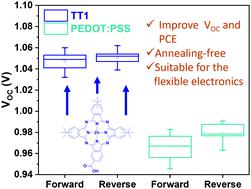当前位置:
X-MOL 学术
›
Nanoscale Horiz.
›
论文详情
Our official English website, www.x-mol.net, welcomes your
feedback! (Note: you will need to create a separate account there.)
Self-assembled Zn phthalocyanine as a robust p-type selective contact in perovskite solar cells.
Nanoscale Horizons ( IF 8.0 ) Pub Date : 2020-08-11 , DOI: 10.1039/d0nh00443j Ece Aktas 1 , Jesús Jiménez-López , Kobra Azizi , Tomas Torres , Emilio Palomares
Nanoscale Horizons ( IF 8.0 ) Pub Date : 2020-08-11 , DOI: 10.1039/d0nh00443j Ece Aktas 1 , Jesús Jiménez-López , Kobra Azizi , Tomas Torres , Emilio Palomares
Affiliation

|
The use of self-assembled monolayers (SAMs) as selective charge extracting layers in perovskite solar cells is a great approach to replace the commonly used charge selective contacts, as they can easily modify the interface to enhance the final solar cell performance. Here, we report a novel synthetic approach of the commonly known zinc phtalocyanine (ZnPc) molecule TT1, widely employed in dye-sensitized solar cells and previously used in perovskite solar cells. TT1 is used as a p-type selective contact, and it demonstrates its ability to form SAM on top of the indium tin oxide (ITO) transparent electrode, obtaining higher efficiencies compared to Pedot:PSS based perovskite solar cells. The differences observed, with an enhanced open-circuit voltage and overall efficiency in TT1 devices are correlated with differences in energetics rather than recombination kinetics.
中文翻译:

自组装锌酞菁在钙钛矿太阳能电池中作为坚固的p型选择性触点。
在钙钛矿太阳能电池中使用自组装单层(SAMs)作为选择性电荷提取层是一种替代常用电荷选择性接触的好方法,因为它们可以轻松地修改界面以增强最终的太阳能电池性能。在这里,我们报告了一种新颖的合成方法,即众所周知的酞菁锌(ZnPc)分子TT1,该方法广泛用于染料敏化太阳能电池,而以前用于钙钛矿太阳能电池。TT1用作p型选择性触点,它展示了其在铟锡氧化物(ITO)透明电极上形成SAM的能力,与基于Pedot:PSS的钙钛矿太阳能电池相比,具有更高的效率。观察到的差异,
更新日期:2020-09-28
中文翻译:

自组装锌酞菁在钙钛矿太阳能电池中作为坚固的p型选择性触点。
在钙钛矿太阳能电池中使用自组装单层(SAMs)作为选择性电荷提取层是一种替代常用电荷选择性接触的好方法,因为它们可以轻松地修改界面以增强最终的太阳能电池性能。在这里,我们报告了一种新颖的合成方法,即众所周知的酞菁锌(ZnPc)分子TT1,该方法广泛用于染料敏化太阳能电池,而以前用于钙钛矿太阳能电池。TT1用作p型选择性触点,它展示了其在铟锡氧化物(ITO)透明电极上形成SAM的能力,与基于Pedot:PSS的钙钛矿太阳能电池相比,具有更高的效率。观察到的差异,











































 京公网安备 11010802027423号
京公网安备 11010802027423号